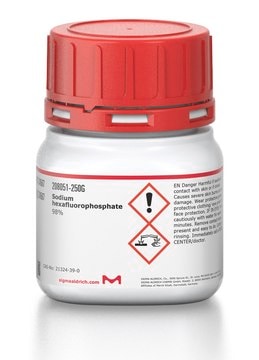931950
Sodium perchlorate
anhydrous, ≥99.9% trace metals basis
Sinónimos:
Sodium Perchlorate, Hyperchloric acid sodium salt
About This Item
Productos recomendados
grade
anhydrous
battery grade
Quality Level
assay
≥99.9% trace metals basis
form
powder
impurities
≤1000 ppm (trace metals analysis)
pH
6.0-8.0 (25 °C, 5%, aq.sol.)
mp
482 °C
solubility
H2O: 209 g/dL at 15 °C
anion traces
chloride (Cl-): ≤30 ppm
sulfate (SO42-): ≤20 ppm
cation traces
Fe: ≤5 ppm
K: ≤500 ppm
application(s)
battery manufacturing
InChI
1S/ClHO4.Na/c2-1(3,4)5;/h(H,2,3,4,5);/q;+1/p-1
InChI key
BAZAXWOYCMUHIX-UHFFFAOYSA-M
¿Está buscando productos similares? Visita Guía de comparación de productos
General description
Application
Packaging
25 g in glass bottle
signalword
Danger
hcodes
Hazard Classifications
Acute Tox. 4 Oral - Eye Irrit. 2 - Ox. Sol. 1 - STOT RE 2
target_organs
Thyroid
Storage Class
5.1A - Strongly oxidizing hazardous materials
wgk_germany
WGK 1
Certificados de análisis (COA)
Busque Certificados de análisis (COA) introduciendo el número de lote del producto. Los números de lote se encuentran en la etiqueta del producto después de las palabras «Lot» o «Batch»
¿Ya tiene este producto?
Encuentre la documentación para los productos que ha comprado recientemente en la Biblioteca de documentos.
Nuestro equipo de científicos tiene experiencia en todas las áreas de investigación: Ciencias de la vida, Ciencia de los materiales, Síntesis química, Cromatografía, Analítica y muchas otras.
Póngase en contacto con el Servicio técnico









